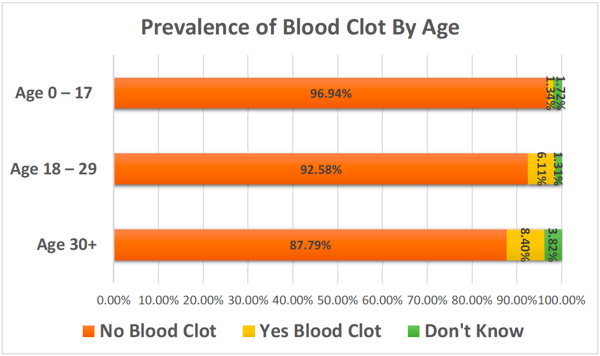People with PWS have a higher risk for developing blood clots than the general population, but the risk is poorly understood. A recent study explored whether testing for a protein called D-dimer could be an informative tool for predicting blood clot risk in the asymptomatic PWS population. Although the study concluded that the test was not likely to be useful for this purpose, it yielded important information as clinicians continue to look for ways to identify blood clots early.
 About the D-Dimer Study
About the D-Dimer Study
One potential laboratory “marker” for blood clots is D-dimer, a small protein that breaks away from clots and circulates in the blood. To determine whether D-dimer levels might be different in those with PWS compared to typical individuals, and to test whether D-dimer levels might predict who is at highest risk for blood clots, in October 2018, a D-dimer sub-study of the 4-year PATH for PWS natural history study was launched. The goal was to measure D-dimer levels in individuals with PWS who didn’t have symptoms of blood clots, to determine if D-dimer testing might be a useful screening method to find those at risk for blood clots (thrombosis). In addition to the D-dimer sub-study, an analysis of responses from the Thrombosis Risk History survey in the Global PWS Registry was completed. The findings of the D-dimer analysis and the Thrombosis Risk survey study have now been published and the results are summarized below.
Study Participants and Method
U.S. participants in the PATH for PWS study could elect to participate in the D-dimer sub-study, which entailed collecting a blood sample at a LabCorp near the participant’s home. In total, 214 asymptomatic individuals ages 5-55 with PWS completed the blood draw (a big thank you to the participants!). In looking at the results of the blood test, approximately 15% of participants had high D-dimer concentrations and 3.7% had D-dimer concentrations greater than twice the upper limit of normal. All participants with D-dimer concentrations that exceeded normal limits were referred to their medical care provider for evaluation and those with concentrations greater than two times the normal limit were also asked to repeat the testing. Upon repeat testing, most of those with high D-dimer levels still had elevated D-dimer concentrations. Of the 214 participants, one participant was identified as actually having a blood clot. Overall, those with abnormal D-dimer levels did not differ significantly from those with normal D-dimer levels when considering factors such as age, gender, genetic subtype, or body mass index (a measure of obesity).
New Data on Risk of Blood Clots in PWS
With respect to the Thrombosis Risk Survey, a total of 883 surveys were completed for individuals with PWS, of which 49% were reported as having Deletion subtype, 32.3 % UPD subtype, 2.8% Imprinting Defect, and the remaining documented as unknown/other/unreported. In the study sample overall, 3.6% of the participants with PWS had a history of blood clots. The prevalence of blood clots increased with age, such that 8% of individuals 30 years or older reported at least one blood clot. Of those individuals with a history of blood clots, 50% reported this first occurred between 18-29 years of age and 31.25% reported the first event occurred at age 17 or younger. This represents a much higher frequency of blood clots in PWS compared to the general population, where the risk for blood clots is approximately 1% at age 80 years or older. Additionally, the age of onset is much younger in PWS, with many reporting blood clots in childhood.

Edema and Blood Clots in PWS
Of significance, those with a history of edema (excess fluid in body tissues) were found to have a higher prevalence of blood clots compared to those with no history or unknown history of edema. Of those reporting a history of edema, 10% had a history of blood clots as compared to a blood clot incidence of 2.5% in those without a reported history of edema. Also of note, when comparing those with a known PWS subtype, a statistically significant difference was found among those with Deletion having blood clots (4.9%) as compared to UPD (1.4%) and Imprinting Defect (0%), though conclusions about the overall risk to those with Imprinting Defect cannot be drawn due to the small sample size.
Conclusion
In conclusion, although this study provided several important insights into blood clots in PWS, the rate of diagnosed blood clots in the D-dimer study was low (1 of 32 with elevated D-dimer concentrations, 3% yield). The low yield combined with no significant differences in D-dimer concentrations based on age or other risk factors suggests that this test is unlikely to be an informative tool for predicting blood clot risk in the asymptomatic PWS population. Although disappointing, this is PWS research study yielded important information as clinicians continue to look for ways to identify blood clots early.
We truly appreciate all of the PATH for PWS study participants who participated in the D-dimer sub-study and those in the Global PWS Registry who completed the Thrombosis Risk History survey. Your commitment to this study and others has had a direct and meaningful impact on PWS research!








